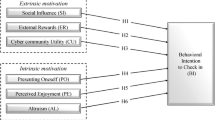Abstract
This study, based on means-end chains (MECs) and push-pull-mooring (PPM) model, aims to reveal the functional attributes of Facebook (FB) and Instagram (IG), classify them into PPM model (i.e., push, pull, and mooring effect), and then integrate the nature of MECs (i.e., attribute-consequence-value linkages) to analyze young people’s perceptions toward FB and IG and their switching intention. By integrating MEC results and PPM model, a hybrid hierarchical value map (HVM) was constructed to provide a complete picture of FB/IG users’ switching intention. The hybrid HVM shows that “hiding posts from someone” and “privacy settings” (push effects) are the unfavorable attributes of FB to push FB users to migrate to IG, while “direct function” and “‘tag’ function” (pull effects) are the favorable attributes of IG to attract FB users to migrate. Moreover, the “photo filter” and “tracking public figures or fan pages” (mooring effect) are the attributes that facilitate or impede FB users to migrate. By understanding the hybrid HVM, it is possible to provide designers with valuable insights for FB/IG design and improvement, so the managers and designers of social networking sites are able to develop their effective business strategies.
You have full access to this open access chapter, Download conference paper PDF
Similar content being viewed by others
This study, based on means-end chains (MECs) and push-pull-mooring (PPM) model, aims to reveal the functional attributes of Facebook (FB) and Instagram (IG), classify them into PPM model (i.e., push, pull, and mooring effect), and then integrate the nature of MECs (i.e., attribute-consequence-value linkages) to analyze young people’s perceptions toward FB and IG and their switching intention. By integrating MEC results and PPM model, a hybrid hierarchical value map (HVM) was constructed to provide a complete picture of FB/IG users’ switching intention. The hybrid HVM shows that “hiding posts from someone” and “privacy settings” (push effects) are the unfavorable attributes of FB to push FB users to migrate to IG, while “direct function” and “‘tag’ function” (pull effects) are the favorable attributes of IG to attract FB users to migrate. Moreover, the “photo filter” and “tracking public figures or fan pages” (mooring effect) are the attributes that facilitate or impede FB users to migrate. By understanding the hybrid HVM, it is possible to provide designers with valuable insights for FB/IG design and improvement, so the managers and designers of social networking sites are able to develop their effective business strategies.
Author information
Authors and Affiliations
Corresponding author
Editor information
Editors and Affiliations
Rights and permissions
Copyright information
© 2018 Academy of Marketing Science
About this paper
Cite this paper
Lin, CF., Fu, CS. (2018). Exploring the Young People’s Cognitive Structure and Switching Intention Toward Social Networking Sites: An Abstract. In: Krey, N., Rossi, P. (eds) Boundary Blurred: A Seamless Customer Experience in Virtual and Real Spaces. AMSAC 2018. Developments in Marketing Science: Proceedings of the Academy of Marketing Science. Springer, Cham. https://doi.org/10.1007/978-3-319-99181-8_36
Download citation
DOI: https://doi.org/10.1007/978-3-319-99181-8_36
Published:
Publisher Name: Springer, Cham
Print ISBN: 978-3-319-99180-1
Online ISBN: 978-3-319-99181-8
eBook Packages: Business and ManagementBusiness and Management (R0)




